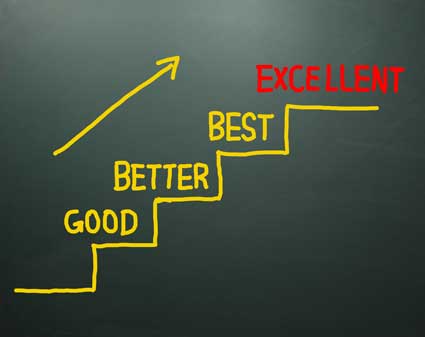At a Glance
Conflict. It makes great television: Whether you're watching a fictional cast of characters, or reality TV, conflict brings in ratings: The greater the level of conflict, the greater the ratings. Television producers purposely create situations that lead to conflict -- whether that means locking a group of young adults into a house filled with cameras, or leaving a dozen castaways stranded on an island with no sleep or food.
Aside from being good television, conflict rarely produces positive results. Conflict -- in a business setting -- is expensive, counter-productive, time consuming, and labor intensive.
We will look at conflict in a business setting and explore ways that you can help to resolve it.
Along the way you'll view some real-life examples. They are found in green boxes like this:
Real-life example: One woman.
As well, you will be able to take part in learning about conflict resolution, by putting into practice what you are reading. Exercises are found in salmon-colored boxes like this:
Exercise: Try this exercise.
But first, conflict starts with identifying what it is, and why it occurs. In this article we will answer those questions and explore the mindset you need to have before you can hope to become an effective mediator.
What is conflict?
Conflict is a disagreement between two or more parties. Although the dictionary may assert that the word "conflict" is synonymous with the word "fight," practical usage suggests that there is a difference. "Fight" suggests a combat - perhaps a conflict that degenerates into two people punching each other. "Conflict" - in a business setting - suggests less physical activity. Both can be harmful, however, to the people engaged.
You may be involved in a conflict in your family or church - two common places where conflict can also occur - and you will get something out of this material. However, please be aware that it is primarily designed for business conflict situations. Moreover, this is a "basic conflict resolution" article and assumes that your conflict is centralized within your business. If you are experiencing conflict between your business and a vendor, or your business and a client, you will find some of this content useful, but it may not all apply.
Why It Happens
No two people are alike. Each one of us brings our very own "world view" with us wherever we go. This world view has been developed by:
Our childhood experiences
Our economic situation
Our family life or home life
Our current health situation
Our overall health
Our education
Our hobbies and interests
Our entertainment choices
Our friends and relatives and other relationships
Our background in similar situations
Our self-esteem
Our assumptions of the other person (or people) involved
Our concept of ourselves
This list may seem long, but there are, in fact, hundreds or even thousands, of other factors that can play a significant part in our attitudes and assumptions. With every interaction we make, whether it is buying gum at a convenience store, getting pulled over for a speeding ticket, negotiating a pay raise with our boss, or going out on the town with some friends -- how we act is defined by how we think; and how we think is defined by our attitudes and assumptions.
Real-life example: One woman was attacked by a dog when she was a child. Although there was no permanent physical scarring, she was emotionally scarred. From that point on, she never liked dogs, whether big or small. Even as an adult, she would show fear around some of the smallest dogs, even though they could not hurt her. The memories she had affected her world view.
Real-life example: One boy was raised with a very strict father. Although never abused, the boy was disciplined strictly. The boy grew up, and when he became a father, he vowed to never raise his child like he was raised. As a result, he gave his own children little discipline and they became very rebellious. His background and his attitudes about discipline affected his world view.
Every moment of every day, our attitudes are being formed and re-formed. Not every attitude we develop is a rational idea, and it is sometimes decided based on faulty information or emotion. (The Nazi world view during World War II would be one example of this.)
If we all had the same world view, there would not be any conflict. However, we do not share world views. Each person's world view is as individual as their fingerprint. As a result, no one sees the same thing exactly the same way. Here is a visual example:
Depending on where the person is, they will have a different view of the cube. One person sees a flat plane, because they are looking at the cube straight-on. Another person sees a square, because they can perceive more than one angle and can make some assumptions. A third person sees a diamond, because they are looking at the square at exactly the angle that makes it appear to extend out from a low point. Lastly, another person, who is a little higher up, sees several angles and realizes that it is a cube.
Exercise: Ask a group of friends to (individually) tell you about a movie they have seen. Do not let them hear the other people's interpretation of the movie. You will get a variety of viewpoints: Some people will focus on the plot; others will focus on the characters or relationships; others will talk about specific details; still others might describe some of the more exciting moments of the movie. In all, you will quickly learn that everyone can spend two hours watching the exact same movie, but no one will ever truly see the same movie.
As a result of our differing world views, we have conflict. Each world view informs our work ethic, it builds assumptions for us, it helps our decision-making skills, and it helps us to understand concepts and ideas.
Unfortunately, since everyone's world view is different, our work ethics will be different, our assumptions will be incorrect, our decision-making will not be the same as other people's, and we may misunderstand (or differently understand) the same concept.
And that's why business conflict arises: because no two people are alike. But we often forget that other people experience or understand things differently from ourselves, and instead, we set our expectations based on how we experience and understand something. When it does not turn out the way we expected, that is the beginning of conflict. (Please note, we are not talking about selfishness here; we are talking about meeting our expectations.)
Types of workplace conflict
There are several types of workplace conflict. We have mentioned some in an earlier paragraph: Here is an exhaustive list of workplace conflict:
1. Horizontal conflict (between two people at approximately equivalent levels on the organizational chart)
2. Vertical conflict (between two people who are at different levels on the organizational chart -- like a supervisor and subordinate, or even between people who are not in the direct reporting line)
3. Outward conflict (between a person or persons in a company, and people or persons who are vendors or customers)
4. Inner conflict (This may surprise you, but it is a real situation in business.)
It is also important to note that this conflict can be between:
One person versus one person
One person versus two or more people (a group)
One group versus one or more groups
Several groups versus several other groups
The more people you add into the mix, the more likely there will be conflict. and the more likely that conflict will be prolonged and intense.
methods in your business to avoid conflict altogether.
Ultimately, conflict needs to be resolved; it cannot simply be ignored in the hopes that it will go away, because the conflict itself may fizzle out in time, but the underlying emotions and attitudes remain and will act like a poison in your company.
Analyze conflict
The first step is to analyze the conflict. When conflict arises, it needs to be dealt with.
In order to analyze the conflict, you need to ask yourself a few questions:
|
1. Am I involved in this conflict in anyway? This includes being a direct participant or being influenced by the outcome of the conflict itself. 2. How am I affected by the conflict, or its outcome? (Answering these two questions will help you to remain objective as you attempt to solve the conflict.) 3. What is the task that is supposed to get done during which the conflict has arisen? (Perhaps it's a group that is meeting to develop a new service, and they can't decide on the service, or maybe the conflict arose simply during the course of normal business practice). 4. Who are the people directly involved in the conflict? On what sides do they fall? 5. Is this conflict a horizontal, vertical, outward, inward, or mixed conflict? 6. What are the main points of each side of the conflict? |
Deal with conflict
It may come on you to mediate. Sometimes conflict requires one of the members of the conflict to mediate, and sometimes a neutral third-party mediator needs to come in. If you are going to mediate, you need to be very honest and clear in your influence over the results of the conflict. If you are influenced at all -- in any way -- you may still be able to mediate, but your position as mediator is greatly disadvantaged by your own world view.
Summary

































